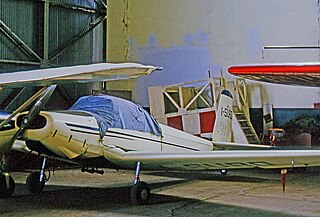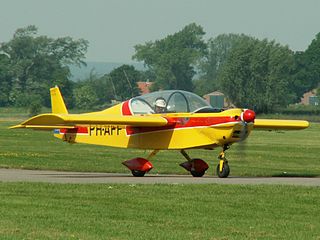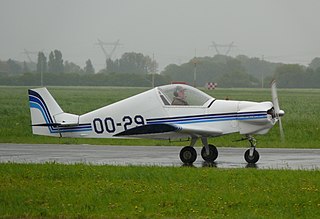Related Research Articles

The Aviamilano P.19 Scricciolo was a light civil trainer aircraft built in Italy in the 1960s.

The Bellanca 14-7 and its successors were a family of light aircraft manufactured in the United States shortly before World War II.
The Boisavia B.260 Anjou was a four-seat twin-engine light aircraft developed in France in the 1950s. It was a low-wing cantilever monoplane of conventional configuration with retractable tricycle undercarriage. Intended by Boisavia as a touring aircraft, it did not find a market and only the single prototype was constructed. At this point, the firm sold the design to SIPA, which modified the design and re-engined it with Lycoming O-360 engines, but found that they could not sell it either. At a time when the twin-engine light plane market was already dominated by all-metal American aircraft, the Anjou's fabric-over-tube construction was something of an anachronism, and all development was soon ceased. Plans to develop a stretched version with three extra seats and Potez 4D engines were also abandoned.

The Piel CP-30 Emeraude is an aircraft designed in France in the mid-1950s and widely built both by factories and homebuilders.

The Focke-Wulf A 20 Habicht was an airliner developed in Germany in the late 1920s. It was a high-wing cantilever monoplane with fixed tailskid undercarriage. The fuselage was deep and seated four passengers in a fully enclosed cabin. The type was not bought by the airlines and only a few examples were built.

The Gourdou-Leseurre GL.30 was a racing aircraft built in France in 1920 which formed the basis for a highly successful family of fighter aircraft based on the same design.

The Italair F.20 Pegaso was a twin-engine utility aircraft designed by Stelio Frati and built in Italy in 1971.
The Hispano HS-42 and its derivative, the HA-43, were advanced military trainer aircraft produced in Spain in the 1940s. The basic design was that of a conventional, low-wing, cantilever monoplane with seating for the pilot and instructor in tandem. The HS-42 had fixed, tailwheel undercarriage with spatted mainwheels, while the HA-43 had retractable main units. Produced on the assembly line that had been used to build Fokker D.XXI fighters, the HS-42 shared some components with this aircraft.
The Issoire Silène was a sailplane produced in France in the 1970s and early 1980s, intended primarily as a trainer. It was a conventional design of fibreglass construction in versions with fixed or retractable monowheel undercarriage. The aircraft featured side-by-side seating for two, with the seats slightly staggered in order to minimise fuselage width. French certification was obtained on 3 February 1978, and production began shortly thereafter at the rate of two aircraft per month.

The Janowski J1 Prząśniczka ("Distaff"), later named the Don Kichot was an ultralight aircraft designed in Poland and marketed for homebuilding in the 1970s. Designed by Jarosław Janowski in 1967 and built with the help of some friends, it flew three years later. It had an unusual design, with a high, strut-braced wing and a pusher propeller mounted behind it. The pilot had a fully enclosed cabin, and the undercarriage was of fixed, tailwheel type. Original prototype was flown with Saturn engine design by Mr Janowski. This engine was made out of two motorcycle engines (MZ250). J1 was also flown with Trabant engine (29HP) and VW conversion (48BPH) made by Christine Aero Engines in Donlands - California.

The Jurca MJ-5 Sirocco is a two-seat sport aircraft designed in France in the early 1960s and marketed for homebuilding. It is one of many wooden homebuilt designs from Romanian born designer Marcel Jurca. Jurca, a Henschel Hs 129 pilot in World War II marketed the plans in Canada and America through Falconar Aviation. It is a low-wing cantilever monoplane of conventional configuration and wooden construction throughout. The tandem seats are enclosed by a bubble canopy, and the tailwheel undercarriage can be built as either fixed or with retractable main units. Marcel Jurca died on 19 October 2001, at which time plans were still available from the designer's web site.

The Wassmer WA-40 Super 4 Sancy is a French single-engined light aircraft of the 1960s and 70s. A single-engined low-winged monoplane with retractable nosewheel undercarriage, variants include the more powerful WA 4/21 Prestige and the WA-41 Baladou with a fixed undercarriage.

The PZL-126 Mrówka (ant) is a Polish agricultural aircraft first flown in 1990. It is a diminutive low-wing monoplane of conventional if stubby appearance with a T-tail, an enclosed cabin and fixed, tricycle undercarriage. Significant parts of the design were undertaken by students at the training college attached to the PZL plant at Okęcie under the direction of Andrzej Słocinski, with the whole project treated initially as a platform for design innovation. Initial design work was completed in 1982 and detail work the following year. Plans to fly a prototype by 1985 were delayed by revisions to the aircraft's equipment, although a mockup was displayed at an agricultural aviation exhibition at Olsztyn that August. Legislation to outlaw certain agricultural chemicals was under consideration in Poland in the late 1980s, spurring interest in biological agents as an alternative and making a tiny aircraft like the Mrówka feasible as a useful piece of agricultural equipment.

The Piel CP.70 Beryl is a French twin-seat, single-engine sport aircraft designed by Claude Piel. It was first flown in France in the 1960s and marketed for amateur construction.

The Pottier P.70 was a single-seat, single-engine sport aircraft developed in France in the 1970s and marketed for homebuilding. It was a mid-wing cantilever monoplane of conventional design with an enclosed cockpit. Originally designed with fixed, tricycle undercarriage, the plans were later revised to offer a fixed, tailwheel option. Construction throughout was of metal. A two-seat, tandem version was developed as the P.170.

The Pottier P.80 is a single-seat, single-engine sport aircraft developed in France in the late 1970s and marketed for homebuilding. Ultimately based on the P.70 design, it features a redesigned wing and cockpit canopy. The P.80 is a low-wing cantilever monoplane of conventional design with an enclosed cockpit. Construction throughout is of metal. The prototype was constructed and unveiled at the 1977 Paris Air Show.
The Pottier P.100 and its derivatives were a family of single-engine aircraft developed in France in the 1970s and 80s. They were high-wing cantilever monoplanes of conventional design with enclosed cabins and fixed tricycle undercarriage. The P.100 had two seats, arranged side-by-side, while the P.110 had its fuselage stretched by 50 cm (20 in) to include a third seat and a greater wingspan. The P.105 was a hybrid of the two designs, featuring the shorter, two-seat fuselage of the P.100 and the longer-span wings of the P.110.

The Rand Robinson KR-1 is a single-seat, single-engine sport aircraft designed in the United States in the early 1970s and marketed for homebuilding. A two-seat version is marketed as the KR-2. It is a low-wing cantilever monoplane of conventional design with an enclosed cockpit and tailwheel undercarriage. As originally designed, the main undercarriage units of the KR-1 and basic KR-2 were manually retractable, folding backwards into the wings, while the KR-2T tandem-seat version had fixed tricycle undercarriage. However, some builders choose fixed tailwheel or even fixed tricycle undercarriage for KR-1s and KR-2s.

The Ruschmeyer R 90-230 RG is a four-seat light aircraft designed and produced in Germany in the late 1980s and early 1990s.

The Scheibe SF-27 Zugvogel V is a single seat Standard Class sailplane, designed and built in Germany in the 1960s. A motorised version was also produced. Significant numbers remain active.
References
| Wikimedia Commons has media related to Pottier aircraft . |
- Jane's All the World's Aircraft 1987–88 . London: Jane's Publishing.
- Taylor, Michael J. H. (1989). Jane's Encyclopedia of Aviation. London: Studio Editions.